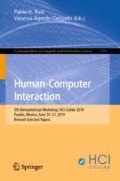Abstract
Most proposals addressing gesture recognition consider two main stages: gesture identification in a source and association between gestures and meanings. About the semantic meaning of gestures, it is important to consider that due to their cultural and linguistic specificity each of them may be mapped to many concepts and vice versa, making them ambiguous and incompletely defined. From the HCI perspective, there is work in the literature presenting elicitation studies on which researchers find gestures sets to allow user interaction with tailored applications under determined contexts. In this paper, we present a full-body language for enabling gesture-based interaction in different contexts. For this purpose, 70 users were asked to provide the gestures they would use as commands within different existing applications, keeping awareness of the relationship between the tasks they were asked to do on the applications and abstract tasks, resulting on 980 gestures which were compared for generating a reduced set of 68 gestures consisting on their graphic representation, a textual description, an anthropometric characterizations for each of them, and generic labels. Interpretation and insights obtained during the experiment are also reported.
Access this chapter
Tax calculation will be finalised at checkout
Purchases are for personal use only
References
Mitra, S., Acharya, T.: Gesture recognition: a survey. IEEE Trans. Syst. Man Cybern. C Appl. Rev. 37(3), 311–324 (2007). https://doi.org/10.1109/tsmcc.2007.893280
Schlömer, T., Poppinga, B., Henze, N., Boll, S.: Gesture recognition with a Wii controller. In: Proceedings of the 2nd International Conference on Tangible and Embedded Interaction, Bonn, Germany, 18–20 February, pp. 11–14. ACM, New York (2008). https://doi.org/10.1145/1347390.1347395
Liang, R.H., Ouhyoung, M.: A real-time continuous gesture recognition system for sign language. In: Proceedings of the Third IEEE International Conference on Automatic Face and Gesture Recognition, Nara, Japan, 14–16 April, pp. 558–567. IEEE (1998). https://doi.org/10.1109/afgr.1998.671007
Daniloff, J.K., Noll, J.D., Fristoe, M., Lloyd, L.L.: Gesture recognition in patients with aphasia. J. Speech Hear. Disord. 47(1), 43–49 (1982). https://doi.org/10.1044/JSHD.4701.43
Jia, P., Hu, H.H., Lu, T., Yuan, K.: Head gesture recognition for hands-free control of an intelligent wheelchair. Ind. Robot 34(1), 60–68 (2007). https://doi.org/10.1108/01439910710718469
Norman, D.A.: Natural user interfaces are not natural. Interactions 17(3), 6–10 (2010). https://doi.org/10.1145/1744161.1744163
Malima, A.K., Özgür, E., Çetin, M.: A fast algorithm for vision-based hand gesture recognition for robot control. In: 14th Signal Processing and Communications Applications, Antalya, Turkey, 17–19 April. IEEE (2006). https://doi.org/10.1109/siu.2006.1659822
Wan, Q., et al.: Gesture recognition for smart home applications using portable radar sensors. In: 2014 36th Annual International Conference of the IEEE Engineering in Medicine and Biology Society (EMBC). IEEE (2014). https://doi.org/10.1109/embc.2014.6945096
Chandler, J., Schwarz, N.: How extending your middle finger affects your perception of others: learned movements influence concept accessibility. J. Exp. Soc. Psychol. 45(1), 123–128 (2009). https://doi.org/10.1016/J.JESP.2008.06.012
Calvary, G., Coutaz, J., Thevenin, D., Limbourg, Q., Bouillon, L., Vanderdonckt, J.: A unifying reference framework for multi-target user interfaces. Interact. Comput. 15(3), 289–308 (2003). https://doi.org/10.1016/S0953-5438(03)00010-9
Kaklanis, N., Moschonas, P., Moustakas, K., Tzovaras, D.: Virtual user models for the elderly and disabled for automatic simulated accessibility and ergonomy evaluation of designs. Univ. Access Inf. Soc. 12(4), 403–425 (2013). https://doi.org/10.1007/s10209-012-0281-0
Wobbrock, J.O., Morris, M.R., Wilson, A.D.: User-defined gestures for surface computing. In: Proceedings of the SIGCHI Conference on Human Factors in Computing Systems, Boston, USA, 04–09 April, pp. 1083–1092. ACM, New York (2009). https://doi.org/10.1145/1518701.1518866
Piumsomboon, T., Clark, A., Billinghurst, M., Cockburn, A.: User-defined gestures for augmented reality. In: Kotzé, P., Marsden, G., Lindgaard, G., Wesson, J., Winckler, M. (eds.) INTERACT 2013. LNCS, vol. 8118, pp. 282–299. Springer, Heidelberg (2013). https://doi.org/10.1007/978-3-642-40480-1_18
Obaid, M., Häring, M., Kistler, F., Bühling, R., André, E.: User-defined body gestures for navigational control of a humanoid robot. In: Ge, S.S., Khatib, O., Cabibihan, J.-J., Simmons, R., Williams, M.-A. (eds.) ICSR 2012. LNCS (LNAI), vol. 7621, pp. 367–377. Springer, Heidelberg (2012). https://doi.org/10.1007/978-3-642-34103-8_37
Motaghi, H.: Creativity and technology in the context of creative industries, dissertation. Université du Québec à Montréal (2015)
Dow, S., Lee, J., Oezbek, C., MacIntyre, B., Bolter, J.D., Gandy, M.: Wizard of Oz interfaces for mixed reality applications. In: CHI 2005 Extended Abstracts on Human Factors in Computing Systems, Portland, USA, 2–7 April, pp. 1339–1342. ACM, New York (2005). https://doi.org/10.1145/1056808.1056911
Höysniemi, J., Hämäläinen, P., Turkki, L.: Wizard of Oz prototyping of computer vision-based action games for children. In: Proceedings of the 2004 Conference on Interaction Design and Children: Building a Community, Maryland, USA, 01–03 June, pp. 27–34. ACM, New York (2004). https://doi.org/10.1145/1017833.1017837
Hoff, L., Hornecker, E., Bertel, S.: Modifying gesture elicitation: do kinaesthetic priming and increased production reduce legacy bias? In: Proceedings of the TEI 2016: Tenth International Conference on Tangible, Embedded, and Embodied Interaction. ACM (2016). https://doi.org/10.1145/2839462.2839472
Connell, S., Kuo, P.Y., Liu, L., Piper, A.M.: A Wizard-of-Oz elicitation study examining child-defined gestures with a whole-body interface. In: Proceedings of the 12th International Conference on Interaction Design and Children, pp. 277–280. ACM, June 2013. https://doi.org/10.1145/2485760.2485823
Liu, J., Zhong, L., Wickramasuriya, J., Vasudevan, V.: uWave: accelerometer-based personalized gesture recognition and its applications. Pervasive Mob. Comput. 5(6), 657–675 (2009). https://doi.org/10.1016/J.PMCJ.2009.07.007
Morris, M.R., Danielescu, A., Drucker, S., Fisher, D., Lee, B., Wobbrock, J.O.: Reducing legacy bias in gesture elicitation studies. Interactions 21(3), 40–45 (2014)
Author information
Authors and Affiliations
Corresponding author
Editor information
Editors and Affiliations
Rights and permissions
Copyright information
© 2019 Springer Nature Switzerland AG
About this paper
Cite this paper
Céspedes-Hernández, D., González-Calleros, J.M. (2019). A Study for the Identification of a Full-Body Gesture Language for Enabling Natural User Interaction. In: Ruiz, P., Agredo-Delgado, V. (eds) Human-Computer Interaction. HCI-COLLAB 2019. Communications in Computer and Information Science, vol 1114. Springer, Cham. https://doi.org/10.1007/978-3-030-37386-3_4
Download citation
DOI: https://doi.org/10.1007/978-3-030-37386-3_4
Published:
Publisher Name: Springer, Cham
Print ISBN: 978-3-030-37385-6
Online ISBN: 978-3-030-37386-3
eBook Packages: Computer ScienceComputer Science (R0)

